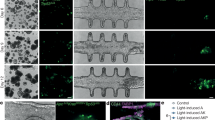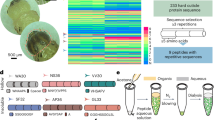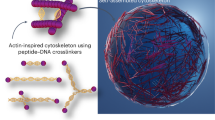Abstract
To exploit the full potential of human pluripotent stem cells for regenerative medicine, developmental biology and drug discovery, defined culture conditions are needed. Media of known composition that maintain human embryonic stem (hES) cells have been developed, but finding chemically defined, robust substrata has proven difficult. We used an array of self-assembled monolayers to identify peptide surfaces that sustain pluripotent stem cell self-renewal. The effective substrates displayed heparin-binding peptides, which can interact with cell-surface glycosaminoglycans and could be used with a defined medium to culture hES cells for more than 3 months. The resulting cells maintained a normal karyotype and had high levels of pluripotency markers. The peptides supported growth of eight pluripotent cell lines on a variety of scaffolds. Our results indicate that synthetic substrates that recognize cell-surface glycans can facilitate the long-term culture of pluripotent stem cells.
This is a preview of subscription content, access via your institution
Access options
Subscribe to this journal
Receive 12 print issues and online access
$259.00 per year
only $21.58 per issue
Buy this article
- Purchase on Springer Link
- Instant access to full article PDF
Prices may be subject to local taxes which are calculated during checkout





Similar content being viewed by others
References
Thomson, J.A. et al. Embryonic stem cell lines derived from human blastocysts. Science 282, 1145–1147 (1998).
Takahashi, K. et al. Induction of pluripotent stem cells from adult human fibroblasts by defined factors. Cell 131, 861–872 (2007).
Yu, J. et al. Induced pluripotent stem cell lines derived from human somatic cells. Science 318, 1917–1920 (2007).
Ludwig, T.E. et al. Derivation of human embryonic stem cells in defined conditions. Nat. Biotechnol. 24, 185–187 (2006).
Yao, S. et al. Long-term self-renewal and directed differentiation of human embryonic stem cells in chemically defined conditions. Proc. Natl. Acad. Sci. USA 103, 6907–6912 (2006).
Wang, L. et al. Self-renewal of human embryonic stem cells requires insulin-like growth factor-1 receptor and ERBB2 receptor signaling. Blood 110, 4111–4119 (2007).
Xu, C. et al. Feeder-free growth of undifferentiated human embryonic stem cells. Nat. Biotechnol. 19, 971–974 (2001).
Martin, M.J., Muotri, A., Gage, F. & Varki, A. Human embryonic stem cells express an immunogenic nonhuman sialic acid. Nat. Med. 11, 228–232 (2005).
Amit, M., Shariki, C., Margulets, V. & Itskovitz-Eldor, J. Feeder layer- and serum-free culture of human embryonic stem cells. Biol. Reprod. 70, 837–845 (2004).
Braam, S.R. et al. Recombinant vitronectin is a functionally defined substrate that supports human embryonic stem cell self renewal via alphavbeta5 integrin. Stem Cells 26, 2257–2265 (2008).
Vuoristo, S. et al. Laminin isoforms in human embryonic stem cells: synthesis, receptor usage and growth support. J. Cell. Mol. Med. 13, 2622–2633 (2009).
Derda, R. et al. Defined substrates for human embryonic stem cell growth identified from surface arrays. ACS Chem. Biol. 2, 347–355 (2007).
Gerecht, S. et al. Hyaluronic acid hydrogel for controlled self-renewal and differentiation of human embryonic stem cells. Proc. Natl. Acad. Sci. USA 104, 11298–11303 (2007).
Li, Y.J., Chung, E.H., Rodriguez, R.T., Firpo, M.T. & Healy, K.E. Hydrogels as artificial matrices for human embryonic stem cell self-renewal. J. Biomed. Mater. Res. A 79, 1–5 (2006).
Harb, N., Archer, T.K. & Sato, N. The Rho-Rock-Myosin signaling axis determines cell-cell integrity of self-renewing pluripotent stem cells. PLoS ONE 3, e3001 (2008).
Melkoumian, Z. et al. Synthetic peptide-acrylate surfaces for long-term self-renewal and cardiomyocyte differentiation of human embryonic stem cells. Nat. Biotechnol. 28, 606–610 (2010).
Villa-Diaz, L.G. et al. Synthetic polymer coatings for long-term growth of human embryonic stem cells. Nat. Biotechnol. 28, 581–583 (2010).
Derda, R. et al. High-throughput discovery of synthetic surfaces that support proliferation of pluripotent cells. J. Am. Chem. Soc. 132, 1289–1295 (2010).
Meng, Y. et al. Characterization of integrin engagement during defined human embryonic stem cell culture. FASEB J. 24, 1056–1065 (2010).
Kolhar, P., Kotamraju, V.R., Hikita, S.T., Clegg, D.O. & Ruoslahti, E. Synthetic surfaces for human embryonic stem cell culture. J. Biotechnol. 146, 143–146 (2010).
Orner, B.P., Derda, R., Lewis, R.L., Thomson, J.A. & Kiessling, L.L. Arrays for the combinatorial exploration of cell adhesion. J. Am. Chem. Soc. 126, 10808–10809 (2004).
Whitesides, G.M., Ostuni, E., Takayama, S., Jiang, X. & Ingber, D.E. Soft lithography in biology and biochemistry. Annu. Rev. Biomed. Eng. 3, 335–373 (2001).
Mrksich, M. & Whitesides, G.M. Using self-assembled monolayers to understand the interactions of man-made surfaces with proteins and cells. Annu. Rev. Bioph. Biom. 25, 55–78 (1996).
Ruoslahti, E. & Pierschbacher, M.D. New perspectives in cell adhesion: RGD and integrins. Science 238, 491–497 (1987).
Lutolf, M.P., Gilbert, P.M. & Blau, H.M. Designing materials to direct stem-cell fate. Nature 462, 433–441 (2009).
Watanabe, K. et al. A ROCK inhibitor permits survival of dissociated human embryonic stem cells. Nat. Biotechnol. 25, 681–686 (2007).
Vogel, B.E. et al. A novel integrin specificity exemplified by binding of the alpha v beta 5 integrin to the basic domain of the HIV Tat protein and vitronectin. J. Cell Biol. 121, 461–468 (1993).
Bishop, J.R., Schuksz, M. & Esko, J.D. Heparan sulphate proteoglycans fine-tune mammalian physiology. Nature 446, 1030–1037 (2007).
Ying, Q.L. et al. The ground state of embryonic stem cell self-renewal. Nature 453, 519–523 (2008).
Engler, A.J., Sen, S., Sweeney, H.L. & Discher, D.E. Matrix elasticity directs stem cell lineage specification. Cell 126, 677–689 (2006).
Ludwig, T.E. et al. Feeder-independent culture of human embryonic stem cells. Nat. Methods 3, 637–646 (2006).
Prokhorova, T. et al. Teratoma formation by human embryonic stem cells is site-dependent and enhanced by the presence of Matrigel. Stem Cells Dev. 18, 47–54 (2008).
Laflamme, M.A. et al. Cardiomyocytes derived from human embryonic stem cells in pro-survival factors enhance function of infarcted rat hearts. Nat. Biotechnol. 25, 1015–1024 (2007).
D'Amour, K.A. et al. Efficient differentiation of human embryonic stem cells to definitive endoderm. Nat. Biotechnol. 23, 1534–1541 (2005).
Chambers, S.M. et al. Highly efficient neural conversion of human ES and iPS cells by dual inhibition of SMAD signaling. Nat. Biotechnol. 27, 275–280 (2009).
Luk, Y.Y., Kato, M. & Mrksich, M. Self-assembled monolayers of alkanethiolates presenting mannitol groups are inert to protein adsorption and cell attachment. Langmuir 16, 9604–9608 (2000).
Klein, E.A., Yung, Y., Castagnino, P., Kothapalli, D. & Assoian, R.K. Cell adhesion, cellular tension, and cell cycle control. Methods Enzymol. 426, 155–175 (2007).
Acknowledgements
We thank R. Derda, B.P. Orner and J.A. Thomson for helpful discussions, J.R. Torrealba for analysis and interpretation of the teratoma data and G.L. Case for help with the automated peptide synthesis. This research was supported by the US National Institutes of Health (R01 grants AI055258 and GM49975) and the University of Wisconsin Materials Research Science and Engineering Center (DMR-0520527). We thank the W.M. Keck Foundation for supporting the Center for Chemical Genomics and the WiCell Research Institute and members of the University of Wisconsin Paul P. Carbone Comprehensive Cancer Center Flow Cytometry Facility (5P30 CA014520-3S) for technical assistance.
Author information
Authors and Affiliations
Contributions
J.R.K., L.L., P.J.W. and L.L.K. conceived the experiments and interpreted the results. J.R.K. performed the in vitro experiments. L.L. synthesized and purified the molecules used to fabricate the surfaces. J.R.K. and M.S.P. conducted the teratoma assay, and P.J.W. conducted the directed differentiation assays. J.R.K. and L.L.K. wrote the manuscript.
Corresponding author
Ethics declarations
Competing interests
L.L.K. is an author on a patent on self-assembled monolayers for stem cell culture (US patent 2007/0207543). L.L.K., J.R.K. and L.L. are authors on a pending patent that describes surfaces for the long-term culture of pluripotent cells (US patent application 20100087004).
Supplementary information
Supplementary Text and Figures
Supplementary Figures 1–11 and Supplementary Tables 1–2 (PDF 37252 kb)
Rights and permissions
About this article
Cite this article
Klim, J., Li, L., Wrighton, P. et al. A defined glycosaminoglycan-binding substratum for human pluripotent stem cells. Nat Methods 7, 989–994 (2010). https://doi.org/10.1038/nmeth.1532
Received:
Accepted:
Published:
Issue Date:
DOI: https://doi.org/10.1038/nmeth.1532
This article is cited by
-
Synthetic alternatives to Matrigel
Nature Reviews Materials (2020)
-
Brain-stiffness-mimicking tilapia collagen gel promotes the induction of dorsal cortical neurons from human pluripotent stem cells
Scientific Reports (2019)
-
Bioengineering strategies to accelerate stem cell therapeutics
Nature (2018)
-
Long-Term Maintenance of Human Pluripotent Stem Cells on cRGDfK-Presenting Synthetic Surfaces
Scientific Reports (2018)
-
Controlling the Interfacial Chemical and Physical Properties for Stem Cell Culture
Topics in Catalysis (2018)



